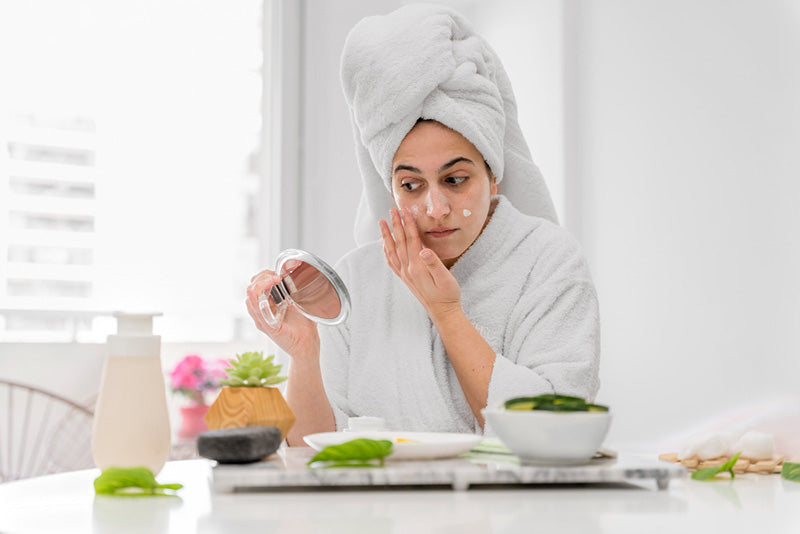How to Balance Oily Skin: Achieving a Radiant Complexion
For many beauticians, understanding how to balance oily skin is crucial in helping clients achieve a healthy, radiant complexion. Oily skin can be challenging, often leading to breakouts, shiny patches, and enlarged pores. However, with the right approach, it's possible to balance oil production and maintain a glowing appearance. In this article, we'll explore effective strategies to manage oily skin, ensuring your clients leave your salon feeling confident and beautiful.

Understanding Oily Skin
Oily skin is characterized by an overproduction of sebum, the natural oil produced by sebaceous glands. This excess oil can lead to a shiny complexion, clogged pores, and acne breakouts. Factors such as genetics, hormonal changes, diet, and environmental conditions can all contribute to oily skin. To effectively manage oily skin, it's essential to understand its underlying causes and develop a tailored skincare routine.
Key Causes of Oily Skin
Understanding the root causes of oily skin can inform your approach to treatment. Genetics play a significant role, as individuals with a family history of oily skin are more likely to experience similar issues. Hormonal changes, particularly during puberty, pregnancy, or menopause, can also trigger increased sebum production. Additionally, diet and lifestyle choices, such as consuming high-glycemic foods or experiencing high stress levels, can exacerbate oily skin conditions.
Essential Skincare Routine for Oily Skin
Developing a consistent skincare routine tailored to oily skin is crucial for managing excess oil and maintaining a healthy complexion. Start by recommending a gentle cleanser that effectively removes dirt and excess oil without stripping the skin of its natural moisture. Follow with an alcohol-free toner to balance the skin's pH levels and reduce the appearance of pores. For more details on creating a skincare routine, check out this guide.
Moisturizing and Sun Protection
Contrary to popular belief, moisturizing is essential for oily skin. Opt for a lightweight, non-comedogenic moisturizer that provides hydration without clogging pores. Additionally, emphasize the importance of daily sun protection. Recommend a broad-spectrum sunscreen with an SPF of at least 30 to protect against UV damage. For tips on choosing the right sunscreen, you can refer to this article.
Incorporating Treatments for Oily Skin
In addition to a solid daily routine, incorporating targeted treatments can further balance oily skin. Consider recommending products containing ingredients like salicylic acid, niacinamide, or retinol, which help to regulate oil production and reduce acne. Regular exfoliation, using chemical exfoliants such as alpha hydroxy acids (AHAs) or beta hydroxy acids (BHAs), can also help to keep pores clear and minimize oil buildup.
At-Home Facial Tips
For clients looking to maintain their skin between salon visits, suggest an at-home facial routine. Start with a gentle exfoliation, followed by a clay mask to absorb excess oil and impurities. Finish with a hydrating serum or moisturizer. For a step-by-step guide on at-home facials, check out this resource.
Diet and Lifestyle Considerations
Diet and lifestyle choices can significantly impact oily skin. Encourage clients to maintain a balanced diet rich in fruits, vegetables, and whole grains while limiting high-glycemic foods and dairy products. Additionally, stress management techniques, such as yoga or meditation, can help to reduce stress-induced oil production. Staying hydrated and getting adequate sleep also play a crucial role in overall skin health.
Hydration and Sleep
Hydration is key to maintaining a balanced complexion. Encourage clients to drink plenty of water throughout the day to support skin health. Proper sleep is equally important, as it allows the body to repair and regenerate skin cells, leading to a more radiant appearance.
Common Mistakes to Avoid
When addressing oily skin, certain common mistakes can hinder progress. Advise clients to avoid over-washing, as this can strip the skin of its natural oils, prompting the sebaceous glands to produce even more oil. Additionally, warn against using harsh, alcohol-based products that can irritate the skin and exacerbate oiliness. Educating clients about these pitfalls can help them achieve better results in managing their skin.
Choosing the Right Products
Selecting the right skincare products is crucial for balancing oily skin. Encourage clients to look for labels that indicate 'non-comedogenic' or 'oil-free' to ensure products won't clog pores. For a deeper understanding of product selection, consider exploring this article.

FAQs
1. Can oily skin be dehydrated?
Yes, oily skin can still be dehydrated. Dehydration occurs when the skin lacks water, whereas oiliness is related to excess sebum production. Ensuring adequate hydration is essential for maintaining skin balance.
2. How often should I exfoliate oily skin?
For oily skin, it's generally recommended to exfoliate 2-3 times a week. Over-exfoliating can lead to irritation and increased oil production, so it's essential to find a balance that works for your client's skin type.
3. Are natural remedies effective for balancing oily skin?
Natural remedies, such as using tea tree oil or witch hazel, can be effective for some individuals. However, it's important to patch-test any new treatment to ensure it doesn't cause irritation or allergic reactions.
This article contains affiliate links. We may earn a commission at no extra cost to you.

